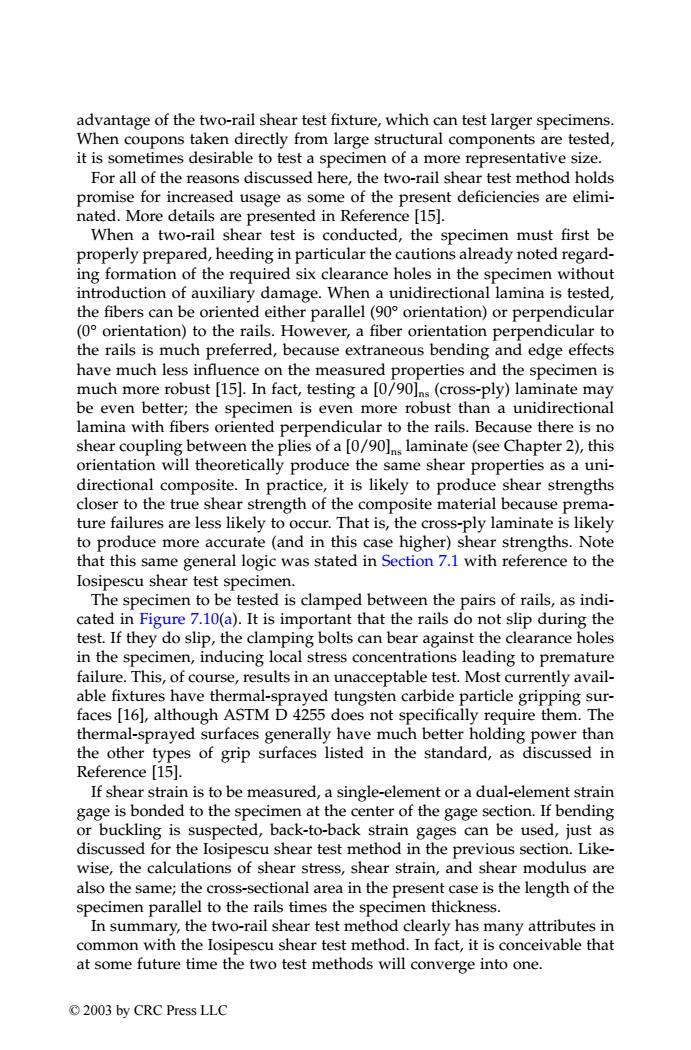正在加载图片...

advantage of the two-rail shear test fixture,which can test larger specimens. When coupons taken directly from large structural components are tested, it is sometimes desirable to test a specimen of a more representative size. For all of the reasons discussed here,the two-rail shear test method holds promise for increased usage as some of the present deficiencies are elimi- nated.More details are presented in Reference [15]. When a two-rail shear test is conducted,the specimen must first be properly prepared,heeding in particular the cautions already noted regard- ing formation of the required six clearance holes in the specimen without introduction of auxiliary damage.When a unidirectional lamina is tested, the fibers can be oriented either parallel(90 orientation)or perpendicular (0 orientation)to the rails.However,a fiber orientation perpendicular to the rails is much preferred,because extraneous bending and edge effects have much less influence on the measured properties and the specimen is much more robust [15].In fact,testing a [0/90]ns(cross-ply)laminate may be even better;the specimen is even more robust than a unidirectional lamina with fibers oriented perpendicular to the rails.Because there is no shear coupling between the plies of a [0/90]ns laminate(see Chapter 2),this orientation will theoretically produce the same shear properties as a uni- directional composite.In practice,it is likely to produce shear strengths closer to the true shear strength of the composite material because prema- ture failures are less likely to occur.That is,the cross-ply laminate is likely to produce more accurate (and in this case higher)shear strengths.Note that this same general logic was stated in Section 7.1 with reference to the losipescu shear test specimen. The specimen to be tested is clamped between the pairs of rails,as indi- cated in Figure 7.10(a).It is important that the rails do not slip during the test.If they do slip,the clamping bolts can bear against the clearance holes in the specimen,inducing local stress concentrations leading to premature failure.This,of course,results in an unacceptable test.Most currently avail- able fixtures have thermal-sprayed tungsten carbide particle gripping sur- faces [16],although ASTM D 4255 does not specifically require them.The thermal-sprayed surfaces generally have much better holding power than the other types of grip surfaces listed in the standard,as discussed in Reference [15]. If shear strain is to be measured,a single-element or a dual-element strain gage is bonded to the specimen at the center of the gage section.If bending or buckling is suspected,back-to-back strain gages can be used,just as discussed for the losipescu shear test method in the previous section.Like- wise,the calculations of shear stress,shear strain,and shear modulus are also the same;the cross-sectional area in the present case is the length of the specimen parallel to the rails times the specimen thickness. In summary,the two-rail shear test method clearly has many attributes in common with the losipescu shear test method.In fact,it is conceivable that at some future time the two test methods will converge into one. 2003 by CRC Press LLCadvantage of the two-rail shear test fixture, which can test larger specimens. When coupons taken directly from large structural components are tested, it is sometimes desirable to test a specimen of a more representative size. For all of the reasons discussed here, the two-rail shear test method holds promise for increased usage as some of the present deficiencies are eliminated. More details are presented in Reference [15]. When a two-rail shear test is conducted, the specimen must first be properly prepared, heeding in particular the cautions already noted regarding formation of the required six clearance holes in the specimen without introduction of auxiliary damage. When a unidirectional lamina is tested, the fibers can be oriented either parallel (90° orientation) or perpendicular (0° orientation) to the rails. However, a fiber orientation perpendicular to the rails is much preferred, because extraneous bending and edge effects have much less influence on the measured properties and the specimen is much more robust [15]. In fact, testing a [0/90]ns (cross-ply) laminate may be even better; the specimen is even more robust than a unidirectional lamina with fibers oriented perpendicular to the rails. Because there is no shear coupling between the plies of a [0/90]ns laminate (see Chapter 2), this orientation will theoretically produce the same shear properties as a unidirectional composite. In practice, it is likely to produce shear strengths closer to the true shear strength of the composite material because premature failures are less likely to occur. That is, the cross-ply laminate is likely to produce more accurate (and in this case higher) shear strengths. Note that this same general logic was stated in Section 7.1 with reference to the Iosipescu shear test specimen. The specimen to be tested is clamped between the pairs of rails, as indicated in Figure 7.10(a). It is important that the rails do not slip during the test. If they do slip, the clamping bolts can bear against the clearance holes in the specimen, inducing local stress concentrations leading to premature failure. This, of course, results in an unacceptable test. Most currently available fixtures have thermal-sprayed tungsten carbide particle gripping surfaces [16], although ASTM D 4255 does not specifically require them. The thermal-sprayed surfaces generally have much better holding power than the other types of grip surfaces listed in the standard, as discussed in Reference [15]. If shear strain is to be measured, a single-element or a dual-element strain gage is bonded to the specimen at the center of the gage section. If bending or buckling is suspected, back-to-back strain gages can be used, just as discussed for the Iosipescu shear test method in the previous section. Likewise, the calculations of shear stress, shear strain, and shear modulus are also the same; the cross-sectional area in the present case is the length of the specimen parallel to the rails times the specimen thickness. In summary, the two-rail shear test method clearly has many attributes in common with the Iosipescu shear test method. In fact, it is conceivable that at some future time the two test methods will converge into one. TX001_ch07_Frame Page 113 Saturday, September 21, 2002 4:58 AM © 2003 by CRC Press LLC